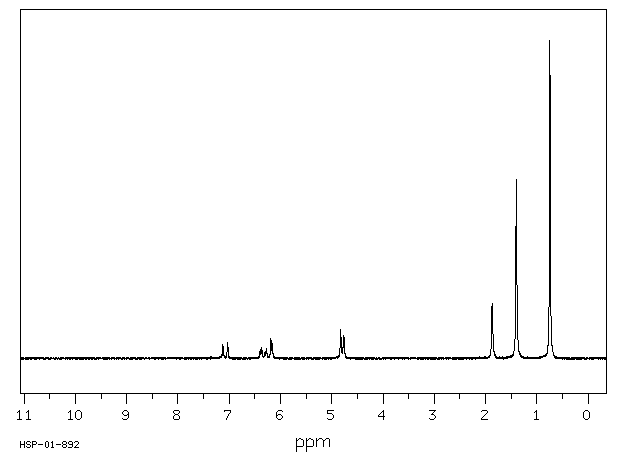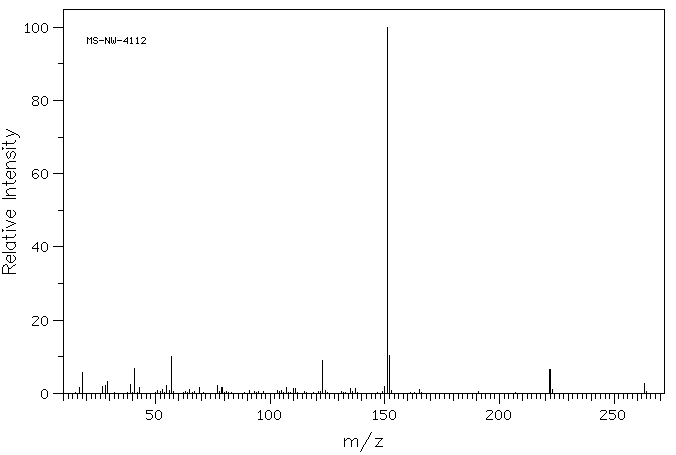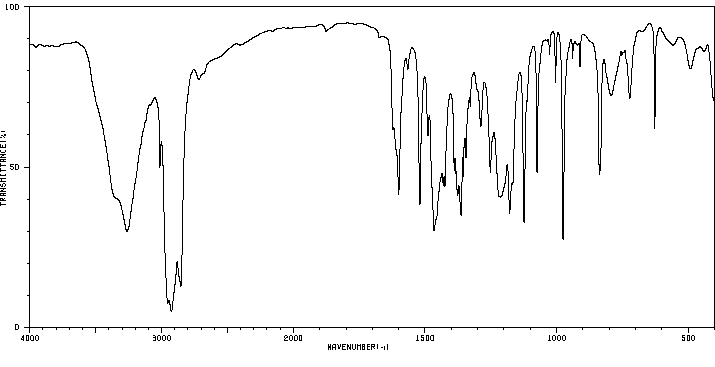4-叔辛基间苯二酚 | 28122-52-3
中文名称
4-叔辛基间苯二酚
中文别名
4-叔辛基雷琐辛
英文名称
4-t-octylresorcinol
英文别名
4-(1,1,3,3-tetramethyl-butyl)-resorcinol;2.4-Dihydroxy-1-(1.1.3.3-tetramethyl-butyl)-benzol;4-(1,1,3,3-Tetramethyl-butyl)-resorcin;1,1,3,3-Tetramethylbutylresorcinol;4-tert-Octylresorcinol;4-(2,4,4-trimethylpentan-2-yl)benzene-1,3-diol
CAS
28122-52-3
化学式
C14H22O2
mdl
MFCD00045770
分子量
222.327
InChiKey
YQOJNENEFSZINP-UHFFFAOYSA-N
BEILSTEIN
——
EINECS
——
-
物化性质
-
计算性质
-
ADMET
-
安全信息
-
SDS
-
制备方法与用途
-
上下游信息
-
文献信息
-
表征谱图
-
同类化合物
-
相关功能分类
-
相关结构分类
物化性质
-
熔点:110 °C
-
稳定性/保质期:
如果按照规格使用和储存,则不会分解,也没有已知的危险反应。
计算性质
-
辛醇/水分配系数(LogP):4.6
-
重原子数:16
-
可旋转键数:3
-
环数:1.0
-
sp3杂化的碳原子比例:0.571
-
拓扑面积:40.5
-
氢给体数:2
-
氢受体数:2
安全信息
-
海关编码:2907299090
SDS
4-叔辛基间苯二酚 修改号码:5
模块 1. 化学品
产品名称: 4-tert-Octylresorcinol
修改号码: 5
模块 2. 危险性概述
GHS分类
物理性危害 未分类
健康危害
皮肤腐蚀/刺激 第2级
严重损伤/刺激眼睛 2A类
环境危害 未分类
GHS标签元素
图标或危害标志
信号词 警告
危险描述 造成皮肤刺激
造成严重眼刺激
防范说明
[预防] 处理后要彻底清洗双手。
穿戴防护手套/护目镜/防护面具。
[急救措施] 眼睛接触:用水小心清洗几分钟。如果方便,易操作,摘除隐形眼镜。继续冲洗。
眼睛接触:求医/就诊
皮肤接触:用大量肥皂和水轻轻洗。
若皮肤刺激:求医/就诊。
脱掉被污染的衣物,清洗后方可重新使用。
模块 3. 成分/组成信息
单一物质/混和物 单一物质
化学名(中文名): 4-叔辛基间苯二酚
百分比: >99.0%(GC)
CAS编码: 28122-52-3
俗名: 4-(1,1,3,3-Tetramethylbutyl)resorcinol
4-叔辛基间苯二酚 修改号码:5
模块 3. 成分/组成信息
分子式: C14H22O2
模块 4. 急救措施
吸入: 将受害者移到新鲜空气处,保持呼吸通畅,休息。若感不适请求医/就诊。
皮肤接触: 立即去除/脱掉所有被污染的衣物。用大量肥皂和水轻轻洗。
若皮肤刺激或发生皮疹:求医/就诊。
眼睛接触: 用水小心清洗几分钟。如果方便,易操作,摘除隐形眼镜。继续清洗。
如果眼睛刺激:求医/就诊。
食入: 若感不适,求医/就诊。漱口。
紧急救助者的防护: 救援者需要穿戴个人防护用品,比如橡胶手套和气密性护目镜。
模块 5. 消防措施
合适的灭火剂: 干粉,泡沫,雾状水,二氧化碳
特定方法: 从上风处灭火,根据周围环境选择合适的灭火方法。
非相关人员应该撤离至安全地方。
周围一旦着火:如果安全,移去可移动容器。
消防员的特殊防护用具: 灭火时,一定要穿戴个人防护用品。
模块 6. 泄漏应急处理
个人防护措施,防护用具, 使用个人防护用品。远离溢出物/泄露处并处在上风处。
紧急措施: 泄露区应该用安全带等圈起来,控制非相关人员进入。
环保措施: 防止进入下水道。
控制和清洗的方法和材料: 清扫收集粉尘,封入密闭容器。注意切勿分散。附着物或收集物应该立即根据合适的
法律法规处置。
模块 7. 操作处置与储存
处理
技术措施: 在通风良好处进行处理。穿戴合适的防护用具。防止粉尘扩散。处理后彻底清洗双手
和脸。
注意事项: 如果粉尘或浮质产生,使用局部排气。
操作处置注意事项: 避免接触皮肤、眼睛和衣物。
贮存
储存条件: 保持容器密闭。存放于凉爽、阴暗处。
远离不相容的材料比如氧化剂存放。
包装材料: 依据法律。
模块 8. 接触控制和个体防护
工程控制: 尽可能安装封闭体系或局部排风系统,操作人员切勿直接接触。同时安装淋浴器和洗
眼器。
个人防护用品
呼吸系统防护: 防尘面具。依据当地和政府法规。
手部防护: 防护手套。
眼睛防护: 安全防护镜。如果情况需要,佩戴面具。
皮肤和身体防护: 防护服。如果情况需要,穿戴防护靴。
模块 9. 理化特性
外形(20°C): 固体
外观: 晶体-粉末
颜色: 白色-微浅黄色
4-叔辛基间苯二酚 修改号码:5
模块 9. 理化特性
气味: 无资料
pH: 无数据资料
熔点:
110°C
沸点/沸程 无资料
闪点: 无资料
爆炸特性
爆炸下限: 无资料
爆炸上限: 无资料
密度: 无资料
溶解度:
[水] 无资料
[其他溶剂] 无资料
模块 10. 稳定性和反应性
化学稳定性: 一般情况下稳定。
危险反应的可能性: 未报道特殊反应性。
须避免接触的物质 氧化剂
危险的分解产物: 一氧化碳, 二氧化碳
模块 11. 毒理学信息
急性毒性: 无资料
对皮肤腐蚀或刺激: 无资料
对眼睛严重损害或刺激: 无资料
生殖细胞变异原性: 无资料
致癌性:
IARC = 无资料
NTP = 无资料
生殖毒性: 无资料
模块 12. 生态学信息
生态毒性:
鱼类: 无资料
甲壳类: 无资料
藻类: 无资料
残留性 / 降解性: 无资料
潜在生物累积 (BCF): 无资料
土壤中移动性
log水分配系数: 无资料
土壤吸收系数 (Koc): 无资料
亨利定律 无资料
constaNT(PaM3/mol):
模块 13. 废弃处置
如果可能,回收处理。请咨询当地管理部门。建议在可燃溶剂中溶解混合,在装有后燃和洗涤装置的化学焚烧炉中
焚烧。废弃处置时请遵守国家、地区和当地的所有法规。
模块 14. 运输信息
联合国分类: 与联合国分类标准不一致
UN编号: 未列明
4-叔辛基间苯二酚 修改号码:5
模块 15. 法规信息
《危险化学品安全管理条例》(2002年1月26日国务院发布,2011年2月16日修订): 针对危险化学品的安全使用、
生产、储存、运输、装卸等方面均作了相应的规定。
模块16 - 其他信息
N/A
模块 1. 化学品
产品名称: 4-tert-Octylresorcinol
修改号码: 5
模块 2. 危险性概述
GHS分类
物理性危害 未分类
健康危害
皮肤腐蚀/刺激 第2级
严重损伤/刺激眼睛 2A类
环境危害 未分类
GHS标签元素
图标或危害标志
信号词 警告
危险描述 造成皮肤刺激
造成严重眼刺激
防范说明
[预防] 处理后要彻底清洗双手。
穿戴防护手套/护目镜/防护面具。
[急救措施] 眼睛接触:用水小心清洗几分钟。如果方便,易操作,摘除隐形眼镜。继续冲洗。
眼睛接触:求医/就诊
皮肤接触:用大量肥皂和水轻轻洗。
若皮肤刺激:求医/就诊。
脱掉被污染的衣物,清洗后方可重新使用。
模块 3. 成分/组成信息
单一物质/混和物 单一物质
化学名(中文名): 4-叔辛基间苯二酚
百分比: >99.0%(GC)
CAS编码: 28122-52-3
俗名: 4-(1,1,3,3-Tetramethylbutyl)resorcinol
4-叔辛基间苯二酚 修改号码:5
模块 3. 成分/组成信息
分子式: C14H22O2
模块 4. 急救措施
吸入: 将受害者移到新鲜空气处,保持呼吸通畅,休息。若感不适请求医/就诊。
皮肤接触: 立即去除/脱掉所有被污染的衣物。用大量肥皂和水轻轻洗。
若皮肤刺激或发生皮疹:求医/就诊。
眼睛接触: 用水小心清洗几分钟。如果方便,易操作,摘除隐形眼镜。继续清洗。
如果眼睛刺激:求医/就诊。
食入: 若感不适,求医/就诊。漱口。
紧急救助者的防护: 救援者需要穿戴个人防护用品,比如橡胶手套和气密性护目镜。
模块 5. 消防措施
合适的灭火剂: 干粉,泡沫,雾状水,二氧化碳
特定方法: 从上风处灭火,根据周围环境选择合适的灭火方法。
非相关人员应该撤离至安全地方。
周围一旦着火:如果安全,移去可移动容器。
消防员的特殊防护用具: 灭火时,一定要穿戴个人防护用品。
模块 6. 泄漏应急处理
个人防护措施,防护用具, 使用个人防护用品。远离溢出物/泄露处并处在上风处。
紧急措施: 泄露区应该用安全带等圈起来,控制非相关人员进入。
环保措施: 防止进入下水道。
控制和清洗的方法和材料: 清扫收集粉尘,封入密闭容器。注意切勿分散。附着物或收集物应该立即根据合适的
法律法规处置。
模块 7. 操作处置与储存
处理
技术措施: 在通风良好处进行处理。穿戴合适的防护用具。防止粉尘扩散。处理后彻底清洗双手
和脸。
注意事项: 如果粉尘或浮质产生,使用局部排气。
操作处置注意事项: 避免接触皮肤、眼睛和衣物。
贮存
储存条件: 保持容器密闭。存放于凉爽、阴暗处。
远离不相容的材料比如氧化剂存放。
包装材料: 依据法律。
模块 8. 接触控制和个体防护
工程控制: 尽可能安装封闭体系或局部排风系统,操作人员切勿直接接触。同时安装淋浴器和洗
眼器。
个人防护用品
呼吸系统防护: 防尘面具。依据当地和政府法规。
手部防护: 防护手套。
眼睛防护: 安全防护镜。如果情况需要,佩戴面具。
皮肤和身体防护: 防护服。如果情况需要,穿戴防护靴。
模块 9. 理化特性
外形(20°C): 固体
外观: 晶体-粉末
颜色: 白色-微浅黄色
4-叔辛基间苯二酚 修改号码:5
模块 9. 理化特性
气味: 无资料
pH: 无数据资料
熔点:
110°C
沸点/沸程 无资料
闪点: 无资料
爆炸特性
爆炸下限: 无资料
爆炸上限: 无资料
密度: 无资料
溶解度:
[水] 无资料
[其他溶剂] 无资料
模块 10. 稳定性和反应性
化学稳定性: 一般情况下稳定。
危险反应的可能性: 未报道特殊反应性。
须避免接触的物质 氧化剂
危险的分解产物: 一氧化碳, 二氧化碳
模块 11. 毒理学信息
急性毒性: 无资料
对皮肤腐蚀或刺激: 无资料
对眼睛严重损害或刺激: 无资料
生殖细胞变异原性: 无资料
致癌性:
IARC = 无资料
NTP = 无资料
生殖毒性: 无资料
模块 12. 生态学信息
生态毒性:
鱼类: 无资料
甲壳类: 无资料
藻类: 无资料
残留性 / 降解性: 无资料
潜在生物累积 (BCF): 无资料
土壤中移动性
log水分配系数: 无资料
土壤吸收系数 (Koc): 无资料
亨利定律 无资料
constaNT(PaM3/mol):
模块 13. 废弃处置
如果可能,回收处理。请咨询当地管理部门。建议在可燃溶剂中溶解混合,在装有后燃和洗涤装置的化学焚烧炉中
焚烧。废弃处置时请遵守国家、地区和当地的所有法规。
模块 14. 运输信息
联合国分类: 与联合国分类标准不一致
UN编号: 未列明
4-叔辛基间苯二酚 修改号码:5
模块 15. 法规信息
《危险化学品安全管理条例》(2002年1月26日国务院发布,2011年2月16日修订): 针对危险化学品的安全使用、
生产、储存、运输、装卸等方面均作了相应的规定。
模块16 - 其他信息
N/A
制备方法与用途
上下游信息
-
下游产品
中文名称 英文名称 CAS号 化学式 分子量 —— [3-Propanoyloxy-4-(2,4,4-trimethylpentan-2-yl)phenyl] propanoate 960602-00-0 C20H30O4 334.456
反应信息
-
作为反应物:描述:4-叔辛基间苯二酚 在 sodium hydroxide 、 溴 、 溶剂黄146 作用下, 生成 5-benzoyloxy-4-bromo-2-(1,1,3,3-tetramethyl-butyl)-phenol参考文献:名称:Stabilization and Solidification of Metal-Laden Wastes by Compaction and Magnesium Phosphate-Based Binder摘要:Bench-scale and full-scale investigations of waste stabilization and volume reduction were conducted using spiked soil and ash wastes containing heavy metals such as Cd, Cr, Pb, Ni, and Hg. The waste streams were stabilized and solidified using chemically bonded phosphate ceramic (CBPC) binder, and then compacted by either uniaxial or harmonic press for volume reduction. The physical properties of the final waste forms were determined by measuring volume reduction, density, porosity, and compressive strength. The leachability of heavy metals in the final waste forms was determined by a toxicity characteristic leaching procedure (TCLP) test and a 90-day immersion test (ANS 16.1). The structural composition and nature of waste forms were determined by X-ray diffraction (XRD) and scanning electron microscopy (SEM), respectively.CBPC binder and compaction can achieve 80-wt % waste loading and 39-47% reduction in waste volume. Compressive strength of final waste forms ranged from 1500 to 2000 psi. TCLP testing of waste forms showed that all heavy metals except Hg passed the TCLP limits using the phosphate-based binder. When Na2S was added to the binder, the waste forms also passed TCLP limits for Hg. Long-term leachability resistance of the final waste forms was achieved for all metals in both soil and ash wastes, and the leachability index was similar to 14. XRD patterns of waste forms indicated vermiculite in the ash waste was chemically incorporated into the CBPC matrix. SEM showed that waste forms are layered when compacted by uniaxial press and are homogeneous when compacted by harmonic press.DOI:10.1080/10473289.2000.10464193
-
作为产物:参考文献:名称:Stabilization and Solidification of Metal-Laden Wastes by Compaction and Magnesium Phosphate-Based Binder摘要:Bench-scale and full-scale investigations of waste stabilization and volume reduction were conducted using spiked soil and ash wastes containing heavy metals such as Cd, Cr, Pb, Ni, and Hg. The waste streams were stabilized and solidified using chemically bonded phosphate ceramic (CBPC) binder, and then compacted by either uniaxial or harmonic press for volume reduction. The physical properties of the final waste forms were determined by measuring volume reduction, density, porosity, and compressive strength. The leachability of heavy metals in the final waste forms was determined by a toxicity characteristic leaching procedure (TCLP) test and a 90-day immersion test (ANS 16.1). The structural composition and nature of waste forms were determined by X-ray diffraction (XRD) and scanning electron microscopy (SEM), respectively.CBPC binder and compaction can achieve 80-wt % waste loading and 39-47% reduction in waste volume. Compressive strength of final waste forms ranged from 1500 to 2000 psi. TCLP testing of waste forms showed that all heavy metals except Hg passed the TCLP limits using the phosphate-based binder. When Na2S was added to the binder, the waste forms also passed TCLP limits for Hg. Long-term leachability resistance of the final waste forms was achieved for all metals in both soil and ash wastes, and the leachability index was similar to 14. XRD patterns of waste forms indicated vermiculite in the ash waste was chemically incorporated into the CBPC matrix. SEM showed that waste forms are layered when compacted by uniaxial press and are homogeneous when compacted by harmonic press.DOI:10.1080/10473289.2000.10464193
文献信息
-
Development of pH-Responsive Fluorescent False Neurotransmitters作者:Minhee Lee、Niko G. Gubernator、David Sulzer、Dalibor SamesDOI:10.1021/ja101740k日期:2010.7.7We introduce pH-responsive fluorescent false neurotransmitters (pH-responsive FFNs) as novel probes that act as vesicular monoamine transporter (VMAT) substrates and ratiometric fluorescent pH sensors. The development of these agents was achieved by systematic molecular design that integrated several structural elements, including the aminoethyl group (VMAT recognition), halogenated hydroxy-coumarin我们引入了 pH 响应荧光假神经递质(pH 响应 FFN)作为新型探针,作为囊泡单胺转运蛋白 (VMAT) 底物和比率荧光 pH 传感器。这些药物的开发是通过系统分子设计实现的,该设计集成了几个结构元素,包括氨乙基(VMAT 识别)、卤化羟基香豆素核(在所需 pH 范围内的比例光学 pH 传感)和 N-或 C-烷基化(调节亲脂性)。在合成的 14 种化合物中,基于 VMAT2 转染的 HEK 细胞的最高吸收和所需的光学特性选择了探针 Mini202。使用 Mini202,我们通过双光子荧光显微镜测量了 PC-12 细胞中儿茶酚胺分泌囊泡的 pH 值(pH 值约为 5.9)。与甲基苯丙胺孵育导致囊泡 pH 值升高(pH 值约为 6.4),这与该精神兴奋剂的拟议作用机制一致,并最终导致囊泡内容物(包括 Mini202)从囊泡到细胞质的重新分布。Mini202 足够明亮、光稳定,适用于双光子显微
-
PREPARATION COMPRISING CHROMAN-2-ONE DERIVATIVES申请人:Mujica-Fernaud Teresa公开号:US20100291009A1公开(公告)日:2010-11-18The invention relates to preparations comprising at least one compound of the formula (I), where the substituents R 1 to R 4 have a meaning indicated in claim 1 , and salts and solvates thereof, and to the use thereof and selected compounds of the formula (I).该发明涉及包含至少一种式(I)化合物的制剂,其中取代基R1至R4具有权利要求1中指示的含义,以及其盐和溶剂合物,以及其用途和选择的式(I)化合物。
-
Highly regioselective propanoylation of dihydroxybenzenes mediated by Candida antarctica lipase B in organic solvents作者:Toshifumi Miyazawa、Manabu Hamada、Ryohei Morimoto、Takashi Murashima、Takashi YamadaDOI:10.1016/j.tetlet.2007.10.124日期:2008.1Candida antarctica lipase B (CAL-B) was found to be a highly active biocatalyst for the direct acylation of the phenolic hydroxyls of substituted hydroquinones and resorcinols with vinyl propanoate as an acyl donor. The acylation reactions took place generally in a very regioselective manner. Especially in the case of 4-substituted resorcinols, the hydroxyl remote from the substituent was regiospecifically
-
MODIFIER FOR AROMATIC POLYESTER AND AROMATIC POLYESTER RESIN COMPOSITION COMPRISING THE SAME申请人:TABATA Masayoshi公开号:US20110224343A1公开(公告)日:2011-09-15The present invention provides a modifier for aromatic polyesters which enhances the melt fluidity of aromatic polyesters without a significant decrease in the heat resistance of the aromatic polyesters, and an aromatic polyester resin composition including the modifier for aromatic polyesters. The present invention relates to a modifier for aromatic polyesters comprising polyhydric phenol residues and residues of aromatic polycarboxylic acid, acid halide or acid anhydride thereof, and the modifier comprises a material having a structure composed of a first residue selected from the group consisting of divalent residues represented by Formula (I): —Ar—W 1 x —Ar— and by Formula (II): —Ar—, the first residues being bonded to two identical or different second residues selected from the group consisting of monovalent residues represented by Formula (III): and monovalent residues represented by Formula (IV): —O—C(O)—R 7 —.
-
Process for preparing hydroxyflavan compounds申请人:SUMITOMO CHEMICAL COMPANY, LIMITED公开号:EP0688770A2公开(公告)日:1995-12-27A process for preparing a hydroxyflavan compound which comprises reacting a polyhydric phenol compound of formula (2): wherein at least one of W, X, Y and Z is hydroxy; with a ketone in the presence of (i) an acid catalyst and (ii) water and/or a seed crystal, using an organic solvent which is insoluble in water, produces the hydroxyflavan compound in high yield and with high selectivity while maintaining high conversion of the polyhydric phenol.
表征谱图
-
氢谱1HNMR
-
质谱MS
-
碳谱13CNMR
-
红外IR
-
拉曼Raman
-
峰位数据
-
峰位匹配
-
表征信息
同类化合物
(βS)-β-氨基-4-(4-羟基苯氧基)-3,5-二碘苯甲丙醇
(S,S)-邻甲苯基-DIPAMP
(S)-(-)-7'-〔4(S)-(苄基)恶唑-2-基]-7-二(3,5-二-叔丁基苯基)膦基-2,2',3,3'-四氢-1,1-螺二氢茚
(S)-盐酸沙丁胺醇
(S)-3-(叔丁基)-4-(2,6-二甲氧基苯基)-2,3-二氢苯并[d][1,3]氧磷杂环戊二烯
(S)-2,2'-双[双(3,5-三氟甲基苯基)膦基]-4,4',6,6'-四甲氧基联苯
(S)-1-[3,5-双(三氟甲基)苯基]-3-[1-(二甲基氨基)-3-甲基丁烷-2-基]硫脲
(R)富马酸托特罗定
(R)-(-)-盐酸尼古地平
(R)-(-)-4,12-双(二苯基膦基)[2.2]对环芳烷(1,5环辛二烯)铑(I)四氟硼酸盐
(R)-(+)-7-双(3,5-二叔丁基苯基)膦基7''-[((6-甲基吡啶-2-基甲基)氨基]-2,2'',3,3''-四氢-1,1''-螺双茚满
(R)-(+)-7-双(3,5-二叔丁基苯基)膦基7''-[(4-叔丁基吡啶-2-基甲基)氨基]-2,2'',3,3''-四氢-1,1''-螺双茚满
(R)-(+)-7-双(3,5-二叔丁基苯基)膦基7''-[(3-甲基吡啶-2-基甲基)氨基]-2,2'',3,3''-四氢-1,1''-螺双茚满
(R)-(+)-4,7-双(3,5-二-叔丁基苯基)膦基-7“-[(吡啶-2-基甲基)氨基]-2,2”,3,3'-四氢1,1'-螺二茚满
(R)-3-(叔丁基)-4-(2,6-二苯氧基苯基)-2,3-二氢苯并[d][1,3]氧杂磷杂环戊烯
(R)-2-[((二苯基膦基)甲基]吡咯烷
(R)-1-[3,5-双(三氟甲基)苯基]-3-[1-(二甲基氨基)-3-甲基丁烷-2-基]硫脲
(N-(4-甲氧基苯基)-N-甲基-3-(1-哌啶基)丙-2-烯酰胺)
(5-溴-2-羟基苯基)-4-氯苯甲酮
(5-溴-2-氯苯基)(4-羟基苯基)甲酮
(5-氧代-3-苯基-2,5-二氢-1,2,3,4-oxatriazol-3-鎓)
(4S,5R)-4-甲基-5-苯基-1,2,3-氧代噻唑烷-2,2-二氧化物-3-羧酸叔丁酯
(4S,4''S)-2,2''-亚环戊基双[4,5-二氢-4-(苯甲基)恶唑]
(4-溴苯基)-[2-氟-4-[6-[甲基(丙-2-烯基)氨基]己氧基]苯基]甲酮
(4-丁氧基苯甲基)三苯基溴化磷
(3aR,8aR)-(-)-4,4,8,8-四(3,5-二甲基苯基)四氢-2,2-二甲基-6-苯基-1,3-二氧戊环[4,5-e]二恶唑磷
(3aR,6aS)-5-氧代六氢环戊基[c]吡咯-2(1H)-羧酸酯
(2Z)-3-[[(4-氯苯基)氨基]-2-氰基丙烯酸乙酯
(2S,3S,5S)-5-(叔丁氧基甲酰氨基)-2-(N-5-噻唑基-甲氧羰基)氨基-1,6-二苯基-3-羟基己烷
(2S,2''S,3S,3''S)-3,3''-二叔丁基-4,4''-双(2,6-二甲氧基苯基)-2,2'',3,3''-四氢-2,2''-联苯并[d][1,3]氧杂磷杂戊环
(2S)-(-)-2-{[[[[3,5-双(氟代甲基)苯基]氨基]硫代甲基]氨基}-N-(二苯基甲基)-N,3,3-三甲基丁酰胺
(2S)-2-[[[[[((1S,2S)-2-氨基环己基]氨基]硫代甲基]氨基]-N-(二苯甲基)-N,3,3-三甲基丁酰胺
(2S)-2-[[[[[[((1R,2R)-2-氨基环己基]氨基]硫代甲基]氨基]-N-(二苯甲基)-N,3,3-三甲基丁酰胺
(2-硝基苯基)磷酸三酰胺
(2,6-二氯苯基)乙酰氯
(2,3-二甲氧基-5-甲基苯基)硼酸
(1S,2S,3S,5S)-5-叠氮基-3-(苯基甲氧基)-2-[(苯基甲氧基)甲基]环戊醇
(1S,2S,3R,5R)-2-(苄氧基)甲基-6-氧杂双环[3.1.0]己-3-醇
(1-(4-氟苯基)环丙基)甲胺盐酸盐
(1-(3-溴苯基)环丁基)甲胺盐酸盐
(1-(2-氯苯基)环丁基)甲胺盐酸盐
(1-(2-氟苯基)环丙基)甲胺盐酸盐
(1-(2,6-二氟苯基)环丙基)甲胺盐酸盐
(-)-去甲基西布曲明
龙蒿油
龙胆酸钠
龙胆酸叔丁酯
龙胆酸
龙胆紫-d6
龙胆紫










